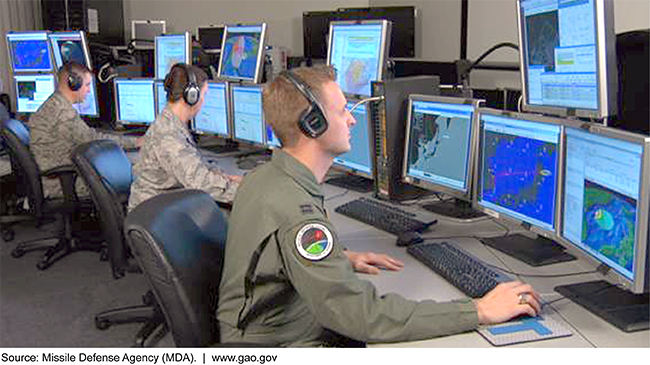Missile Defense: Lessons Learned From Acquisition Efforts
Fast Facts
The Missile Defense Agency is developing a Ballistic Missile Defense System to protect against ballistic and hypersonic missile attacks. MDA has received about $174 billion since 2002 and is requesting another $9.2 billion for fiscal year 2021.
We’ve reported on MDA every year since 2002 and found it has fallen short of its goals, in part because of the high-risk approach it takes to developing these systems. This includes moving ahead on aggressive schedules when key technologies are not yet properly developed.
We testified that MDA has improved its approach to these acquisitions but still uses aggressive schedules and other risky practices.

Missile Defense Agency employees at computer stations with multiple monitors
Highlights
What GAO Found
The Missile Defense Agency (MDA) has taken important steps in recent years to improve management practices, reduce acquisition risks, and deliver capabilities to defend the United States and its allies from ballistic missile attacks. Specifically, MDA has made advances across a broad range of management activities, such as improving stakeholder outreach, reducing concurrency, (broadly defined as the overlap between product development, testing, and production), improving testing of the Ballistic Missile Defense System (BMDS) and increasing transparency of its progress. MDA has also made progress toward improving homeland and regional defense.
However, MDA can go further to align itself with best practices as it faces ongoing challenges associated with improving transparency and reducing high risk acquisition practices. These challenges include:
- Stakeholder involvement: MDA has improved its outreach to stakeholders, including the intelligence community and other DOD stakeholders, however, opportunities remain, such as obtaining more input from the defense intelligence community. While MDA is not required to do so, the community is uniquely positioned to help keep pace with emerging threats and validate threat models.
- Concurrency: MDA has taken steps to reduce concurrency, but falls back on this practice when experiencing developmental delays or schedule pressures. The recently canceled Redesigned Kill Vehicle (RKV) initially aligned production decisions with flight testing. However, in response to advancements from North Korea, development and production were performed concurrently and flight testing was reduced, thereby removing the safeguards that had been put into place.
- Flight test schedule changes: Despite initiating a new approach to developing its flight test schedule in 2009, MDA continues to struggle with execution. Namely, MDA is frequently revising its annual schedule by adding new tests, and deleting or delaying others—sometimes multiple times.
- Transparency of test cost estimates: MDA regularly makes changes to its test schedule without reporting the impact to its costs and funding needs. We continue to believe that breaking out funding requests by test will improve transparency into planned versus actual test costs and aid departmental and congressional decision makers as they make difficult choices of where to invest limited resources.
MDA is at a pivotal crossroads, needing to balance its ability to pursue new and advanced efforts while also maintaining its existing portfolio. Congress and the Secretary of Defense are undertaking multiple reviews to determine how to address these concerns and chart a path forward for MDA.
Why GAO Did This Study
For over half a century, the Department of Defense has funded efforts to defend the United States from ballistic missile attacks. From 2002 to 2020, MDA has received about $174 billion to develop the BMDS and has requested about $9.2 billion for fiscal year 2021. The BMDS consists of diverse and highly complex land-, sea-, and space-based systems and assets located across the globe.
This statement summarizes lessons that GAO has identified from its prior reviews of MDA starting in 2004 that can be applied to strengthen the transparency and acquisition practices for developing and fielding missile defense elements. Specifically, this testimony provides information on (1) steps MDA has taken to increase transparency and reduce acquisition risks; and (2) ongoing challenges associated with improving transparency and reducing high risk acquisition practices. In our prior work, GAO reviewed key MDA management documents including annual program reviews, tests plans and budget documents. We also interviewed officials from MDA and from other key DOD offices.
Recommendations
GAO is not making any new recommendations in this statement. GAO has previously recommended that MDA take steps to increase transparency and align its acquisition approach to reduce high-risk practices. MDA concurred with certain recommendations and is taking steps to implement them.
